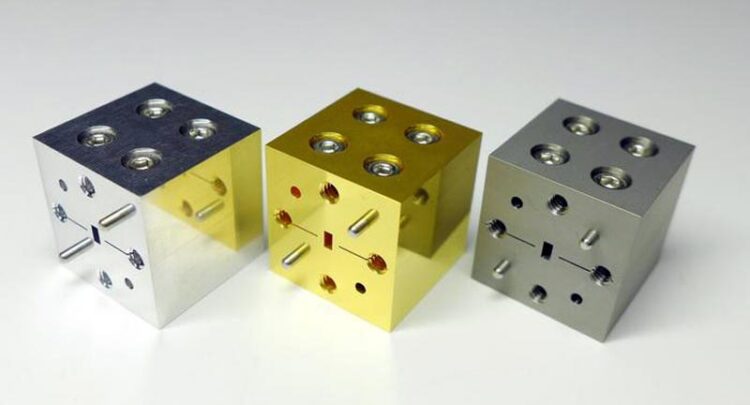Superconducting niobium waveguide achieves high-precision communications for B5G/6G networks

Researchers fabricated 20mm length waveguides made of the superconducting metal niobium (right). It shows improved conductivity compared with normal metal materials such as a gold-plated tellurium copper (middle) and aluminium alloy (left), and can transmit radio waves that are necessary for B5G/6G communications.
Credit: Taku Nakajima
A team of researchers has made a breakthrough discovery in the world of Beyond 5G/6G (B5G/6G) signal transmission. Taku Nakajima and Kazuji Suzuki of Nagoya University in Japan, along with their collaborators, created a waveguide made of niobium that speeds up the transition of B5G/6G signals.
The frequency of data waves has continued to increase as B5G/6G technologies have been introduced. Although the currently used metal transmission lines can handle B5G/6G, research has focused on superconducting metals, such as niobium, that have lower transmission loss and can handle higher frequencies.
Nakajima and his collaborators evaluated the use of niobium in a waveguide, a three-dimensional transmission line consisting of a metal tube that guides and confines waves along a specific path, minimizing losses due to radiation and absorption. However, working with the metal proved to be difficult as it was susceptible to deformation and damage during fabrication and handling.
“Fabricating a physical model of a waveguide was very difficult. At first, it was not possible to process it with any precision at all,” Nakajima said. The result of their first cutting caused a milling burr, an unwanted projection of the metal. “We tried to search for the best cutting tool and cutting parameters and eventually found that diamond-like carbon-coated tools were the best. This trial-and-error process took several months.”
Using their method, the researchers fabricated rectangular waveguides that can transmit radio waves in the 100 GHz band that are necessary for B5G/6G communications. They compared the conductivity of their niobium waveguide with that of common non-superconducting waveguide materials: a gold-plated tellurium copper and aluminium alloy. They tested both at room temperature and at low temperatures because the characteristics of superconducting metals change with cooling, entering what is called the superconducting state, which is characterized by low electrical resistance.
“As expected, we found that the conductivity improves as the temperature of the metal decreases, resulting in reduced losses in the circuit,” said Nakajima. “Using electromagnetic field simulations, we calculated the conductivity and transmission loss of each metal. The conductivity of niobium in the superconducting state was 1,000 to 10,000 times higher than that of the aluminium alloy. Furthermore, the transmission loss of niobium in the superconducting state was calculated to be several tenths that of other metals. These two factors contribute to the creation of a high-quality, high-precision communication environment.”
The results of this study have important implications for uses of their technology for B5G/6G communications. According to Nakajima: “By applying the results of this research, an unprecedented ultra-sensitive receiving system can be realized in radio telescope receivers for astronomical observations, where waveguide circuits are already widely used, and in environmental measurement equipment for the earth’s atmosphere. This will open up new fields of scientific observation using high-frequency radio waves, such as the observation of very distant galaxies in the early universe, which emit only very weak radio waves, or the monitoring of changes in trace atmospheric constituents in the Earth’s upper atmosphere.”
In addition to Nakajima and Suzuki from the Institute for Space-Earth Environmental Research (ISEE) at Nagoya University, the collaborators included researchers from the National Astronomical Observatory of Japan, Kawashima Manufacturing Co., and the National Institute of Information and Communications Technology. The researchers published their findings in the Journal of Physics.
Nagoya University researchers mentioned in the press release:
Assistant Professor Taku Nakajima (he/him), Institute for Space-Earth Environmental Research (ISEE), Nagoya University
Technical Assistant Kazuji Suzuki (he/him), Institute for Space-Earth Environmental Research (ISEE), Nagoya University
Journal: Journal of Physics Conference Series
DOI: 10.1088/1742-6596/2545/1/012021
Article Publication Date: 8-Aug-2023
Media Contact
Matthew Coslett
Nagoya University
kouho-en@adm.nagoya-u.ac.jp
Office: +81 (0)52-747-6862
@NagoyaUniv
All latest news from the category: Physics and Astronomy
This area deals with the fundamental laws and building blocks of nature and how they interact, the properties and the behavior of matter, and research into space and time and their structures.
innovations-report provides in-depth reports and articles on subjects such as astrophysics, laser technologies, nuclear, quantum, particle and solid-state physics, nanotechnologies, planetary research and findings (Mars, Venus) and developments related to the Hubble Telescope.
Newest articles

Trotting robots reveal emergence of animal gait transitions
A four-legged robot trained with machine learning by EPFL researchers has learned to avoid falls by spontaneously switching between walking, trotting, and pronking – a milestone for roboticists as well…

Innovation promises to prevent power pole-top fires
Engineers in Australia have found a new way to make power-pole insulators resistant to fire and electrical sparking, promising to prevent dangerous pole-top fires and reduce blackouts. Pole-top fires pose…

Possible alternative to antibiotics produced by bacteria
Antibacterial substance from staphylococci discovered with new mechanism of action against natural competitors. Many bacteria produce substances to gain an advantage over competitors in their highly competitive natural environment. Researchers…





















